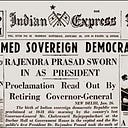Member-only story
The Pulwama attack, which killed 41 Central Armed Reserve Police personnel, was the terrorists’ most dastardly attack since 2001, when it targeted the families of Army personnel. It was the most deadly attack on Indian forces since the Islamist, Pakistani-backed, insurgency in Kashmir began in 1989.
One thing is clear — this was a long time coming. I held serious reservations about last summer’s Ramadan cease-fire as it would only help further ideological consolidation — and unfortunately, so it has proved.
While the number of attacks have gradually decreased, the ferocity of these attacks has been on the rise since the summer of 2016 — when the popular local militant Burhan Wani was gunned down by the Indian Army. In the two years since, the terrorists have been on the run as the Indian forces have pinned them down and eliminated them.
The terrorists’ immediate response to Wani’s killing was a massacre of 19 Indian Army soldiers in Uri in September 2016 — which led to the Indian Army’s surgical strikes, across the Line of Control. The surgical strikes levelled multiple terror launch pads. However, make no mistake — it was a tactical one-off. India also had the element of surprise on her side…
